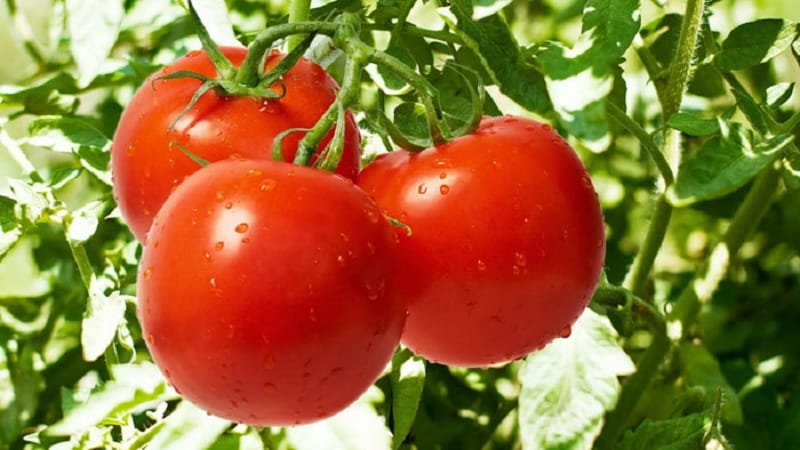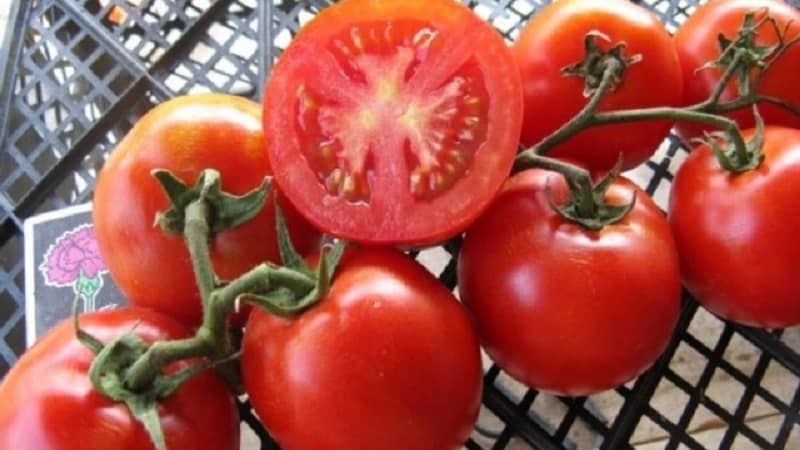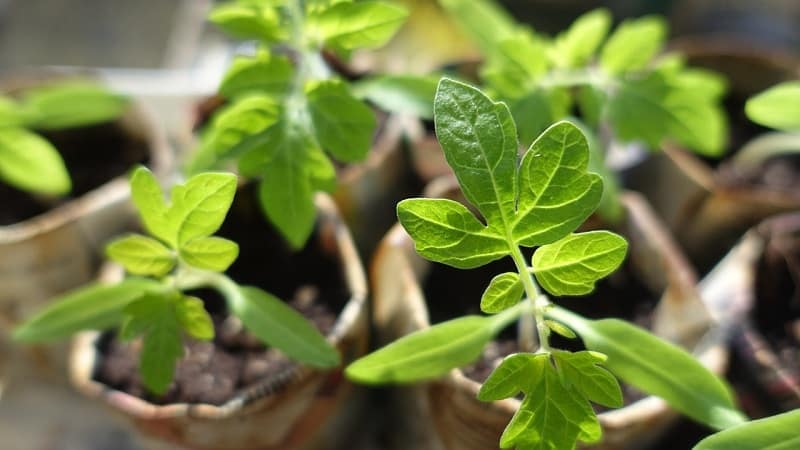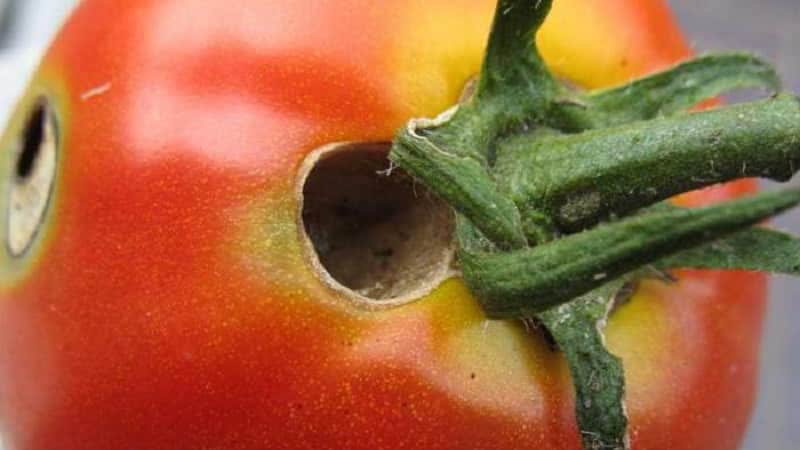How did the “Riddle” variety appear and why is it good for summer residents?
Early ripening tomato varieties are grown for harvest in mid-summer. The ultra-early variety Riddle, which has a ripening period of 80-85 days from the moment of germination, is especially popular among gardeners. The culture is not susceptible to late blight infection and is protected at the genetic level from most viruses and fungi.
History of variety selection
Tomato Riddle - an ultra-early variety of Russian selection for open and closed ground. The culture is not included in the State Register. Seed production is carried out by the Plasmas company (St. Petersburg). Scientists and technologists have developed a unique plasma technology for seed treatment using an electric charge in gas. How it works? The seed material is immersed in a technological chamber, where it is treated with ionized gas.
Advantages of the technology:
- improved germination and increased growth energy;
- improving the taste characteristics of fruits;
- increasing resistance to fungi and bacteria;
- increase in productivity;
- increasing the shelf life of seeds.
The photo shows the Riddle variety.

Description and characteristics of culture
The table shows the distinctive features of the variety.
| Indicators | Characteristic |
| Weight | 80-100 g |
| Form | Slightly ribbed, flat-rounded |
| Coloring | Bright red, without green spot at the stalk |
| Bush height | 30-40 cm |
| Leaves | Medium size, light green |
| Inflorescence | Simple |
| Pulp | Dense, aromatic |
| Taste | Sweet, pleasant |
| Skin | Dense, does not crack |
| Number of slots | 5-6 |
| peduncle | With articulation |
| Purpose | For preservation and fresh consumption |
| Ripening period | 80-85 days after germination |
| Productivity | 20-22 kg/m² |
| Sustainability | To verticillium, fusarium, tomato mosaic virus, cladosporiosis |
| Transportability | High |
Advantages and disadvantages
Advantages of the variety:
- ultra-early maturation;
- high productivity;
- resistance to major nightshade diseases, lack of sunlight;
- the plant does not form stepsons;
- the fruits have a pleasant sweet taste;
- universal use in cooking;
- bushes do not require garter.
No disadvantages of the variety were noted.
Interesting fact. Tomatoes have long been considered poisonous and inedible. In 1822, Colonel Robert Gibbon Johnson ate a bucket of tomatoes in front of a large crowd outside the courthouse in Salem, New Jersey. The stunned crowd was surprised to discover that the soldier did not die a painful death, and the tomato quickly began to gain popularity.

Growing technology
The Riddle variety is grown through seedlings. After transferring to a permanent place, follow the standard cultivation technology - moderate watering, mulching beds, weeding, loosening the soil, applying fertilizers.
Seed preparation
Sowing seeds for seedlings is carried out in late March - early April. Seed material from the manufacturer undergoes plasma treatment in production and does not require additional disinfection or germination.
Varietal seeds collected by hand are processed:
- calibrated by soaking in a saline solution (1 teaspoon of salt per 200 ml of water), specimens that float to the surface are thrown away;
- the seeds remaining at the bottom are washed with running water and immersed in a slightly pink solution of potassium permanganate;
- to protect against mold and fungi, seeds are soaked in a solution of the Baikal EM preparation (5 drops per 200 ml of water);
- To increase germination, seeds are soaked in a solution of Epin Extra, Zircon, Radifarm, Heteroauxin, Biostim.
Soil preparation
To grow tomato seedlings, use ready-made substrate from gardening stores or prepare the soil mixture yourself. In a large bucket, mix 70% turf, 15% peat, humus and river sand, 500 ml of wood ash. The substrate is disinfected in the oven or sprinkled with a strong solution of potassium permanganate or copper sulfate.
Sowing seedlings and care
Any containers for seedlings are suitable - tetrapacks, trays, containers, special boxes, pots. The container is filled 2/3 with soil mixture and the seeds are planted to a depth of 2-3 cm, watered with warm water and covered with polyethylene to create a greenhouse effect. Place the containers in a dark, warm place and wait for germination.
After the first leaves appear, the film is removed and the seedlings are transferred to a lighted windowsill on the south side of the house. At the initial stage of cultivation, seedlings are provided with sufficient sunlight. The optimal length of daylight is 15-16 hours.
Picking is carried out at the stage of 1-2 true leaves.
Watering the seedlings is moderate, once every 5-7 days.
After the daytime air temperature has settled at +10°C, the seedlings are taken out to the balcony for 15-25 minutes for hardening. This increases resistance to temperature changes in open ground or in a greenhouse. Every day the time spent in the air is increased by 30 minutes.
Before transferring to a permanent place, seedlings are fed with mineral complexes.
Recipe first feeding for 1 liter of water:
- urea - 0.5 g;
- potassium salt - 1.5 g;
- superphosphate - 4 g.
Recipe for the second feeding:
- superphosphate - 4 g;
- ammonium nitrate - 0.6 g;
- potassium sulfate - 2 g.
Interval between fertilizing - 15 days.
Planting seedlings in the ground

The seedlings are transferred to the garden or greenhouse after 55-70 days. It is important to make sure that the threat of overnight frost has passed. Planting is carried out in cloudy, windless weather during the day or evening. The location is chosen on the south side, protected from drafts.
The site is prepared in the fall - they dig it up and add humus. In spring, the soil is loosened again and watered with copper sulfate to prevent nightshade diseases. The holes are formed at a depth of 15-20 cm, 10 g of superphosphate is placed in each.
The planting pattern is 60x30 cm. From 6 to 9 bushes are placed per 1 m². The seedlings are removed from the containers and, together with the earthen ball, are transferred into the holes. A layer of soil is poured on top and lightly compacted. The cotyledon leaves are left on the surface.
After transplanting, the seedlings are watered twice with warm, settled water.
In regions with a cool climate, Riddle tomato seedlings are covered with black agrofibre to protect them from frost. This allows the seedlings to take root. PVC pipes are used for the frame. They bend easily to take any shape. The film is periodically lifted to ventilate the seedlings.
Tomato care
Rules for caring for plantings:
- Regularly water with clean water after sunset at the root after the top layer of soil has dried. Before the ovaries appear, 1-2 times every 10 days is enough. The best option for organizing tomato watering is to install a drip system.
- Loosen the soil after each watering so that a dense crust does not appear on the surface, which impedes aeration of the root system.
- Weed out weeds as they grow, preventing plants from taking root.
- Mulch the beds - this stops the growth of weeds and retains moisture in the soil. Sawdust, straw, hay, and peat are used as mulch.
- Tomatoes are fed 2-3 times during the entire growing season. To do this, use complex fertilizers containing potassium, sodium, phosphorus and organic matter.
Fertilizer application scheme:
- 10-14 days after planting, tomatoes are fed with a solution of ammonium nitrate (10-20 g per 10 liters of water).
- During the budding period, a solution of manure with azofoska is added (20 g per 10 l of solution).
- 2 weeks after the second feeding, the beds are watered with a mineral solution (15 g of ammonium nitrate, 25 g of potassium sulfate).
Prevention of diseases and pests
Thanks to early ripening, Riddle tomatoes are not susceptible to infection late blight, and at the genetic level are protected from verticillium, fusarium, tomato mosaic virus, cladosporiosis. However, for the purpose of prevention, plantings are protected from nightshade diseases:
- observe crop rotation;
- ventilate greenhouses;
- treat the soil with copper sulfate;
- disinfect the seed material in a solution of potassium permanganate;
- maintain an optimal level of humidity in the greenhouse (70–80%);
- follow watering rules;
- mulch the beds;
- remove the lower leaves;
- The plantings are treated with Integral and Fitosporin.
Riddle tomatoes are susceptible to attacks by the Colorado potato beetle, spider mite, whiteflies. Insecticides that are highly effective are: “Fitoverm”, “Strela”, “Decis Profi”, “Flumite”, “Confidor”, “Borneo”, “Iskra”.
To combat the gnawing armyworm, use:
- biological product "Lepidocid";
- contact chemical "Decis Expert";
- insecticide "Proclam".
Those who do not accept the use of chemicals for processing tomatoes use folk remedies against insects:
- garlic infusion - 400 g of crushed cloves per 3 liters of water, leave for 5 days, strain and add 50 g of laundry soap shavings;
- wormwood decoction - 500 g of herb per 5 liters of boiling water, leave for 3 days and dilute the concentrated liquid with water 1:10;
- herbal infusion - 50 g of celandine, 70 g of tobacco dust, 50 g of wormwood, 100 g of chopped garlic per 10 liters of boiling water, leave for 24 hours, mix in 30 g of tar soap shavings.
Soap shavings are used for better adhesion of herbal infusions to foliage. Spraying is carried out once every 10 days.

The nuances of growing in open ground and in a greenhouse
In Russia, the Riddle tomato variety is grown everywhere:
- in the south - in open ground;
- in central regions - in greenhouses or greenhouses without a heating system;
- in the north - in heated glass greenhouses.
The plant does not form side shoots, so it does not need pinching. There is also no need to tie up the bushes, however, some gardeners recommend tying up the stems if large fruits form on them, so that they do not lie on the ground. To do this, install low wooden stakes next to the bush and tie the bunches of tomatoes with jute.
Harvesting and application
The fruits are collected after reaching technical ripeness in late June - early July. A large amount of sugar makes tomatoes sweet and tasty. The fruits will appeal to connoisseurs of tomatoes without sourness. They are suitable for preparing fresh salads, pasta sauces, appetizers, and vegetable soups. The thick skin does not crack during heat treatment, which makes it possible to marinate tomatoes in vinegar.
The fruits retain their attractive appearance for 20-30 days if stored in a cool place. To extend the shelf life, it is recommended to collect tomatoes with the stalk.

Reviews
Reviews from gardeners about the Riddle variety are more than positive.
Ivan, Vyazma: “The characteristics and description of the Riddle tomato variety presented on the packaging are true. I prefer to plant early varieties in the greenhouse, and mid-season varieties in the garden. Riddle is liked because of its high yield and disease resistance. During three years of cultivation, the bushes never suffered from late blight. The plant produces vigorous shoots, tomatoes are almost the same size, very tasty, sweet, suitable for pickling. The skin is dense, but not tough.”
Sofia, Voronezh: “The Riddle variety (not to be confused with the Riddle of Nature) is one of the best varieties of domestic selection. I've been growing it for four years in a row and haven't had any problems with it. I buy seeds from the manufacturer, so I do not carry out pre-sowing treatment. The seedlings are strong and do not get sick. After a week of hardening, I plant them in the garden. It is important to provide moderate watering and feed with minerals, then the harvest will be a success.”
Dmitry, Ivanovo: “I chose Riddle tomatoes for their ease of care and lack of acid. They are ideal for winter preparations and seasonal salads. The diameter of the fruits is small, so they fit into a jar without any problems. I pick the tomatoes as soon as they start to turn red and ripen them on the windowsill. I keep it in the cellar for about a month.”
Conclusion
The ultra-early tomato variety Riddle is ideal for those who want to harvest in mid-summer. Low-growing bushes do not need to be tied up; this is done only if large fruits are formed.The plant does not form side shoots, so it does not need pinching, which makes care much easier. Tomatoes grow small in size, have an attractive bright red color, juicy and sweet flesh, and dense but delicate skin.
The culture is unpretentious in care, requires only moderate watering, regular loosening of the soil and removal of weeds, the addition of organic and mineral fertilizing. The fruits are ideal for making winter twists and fresh consumption.